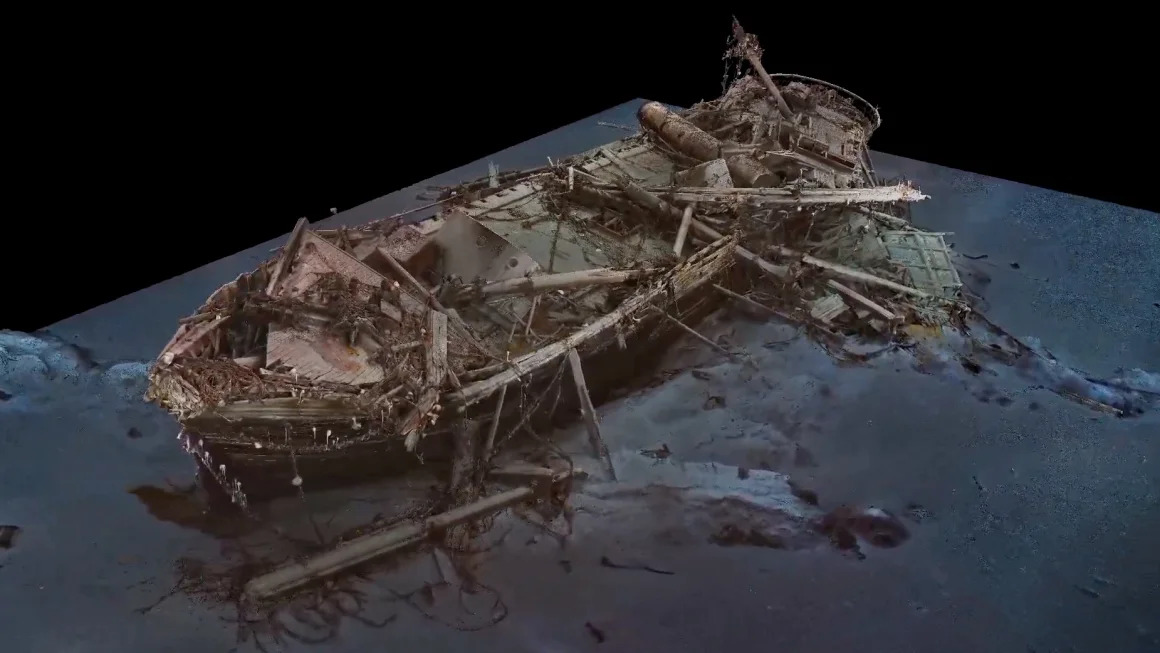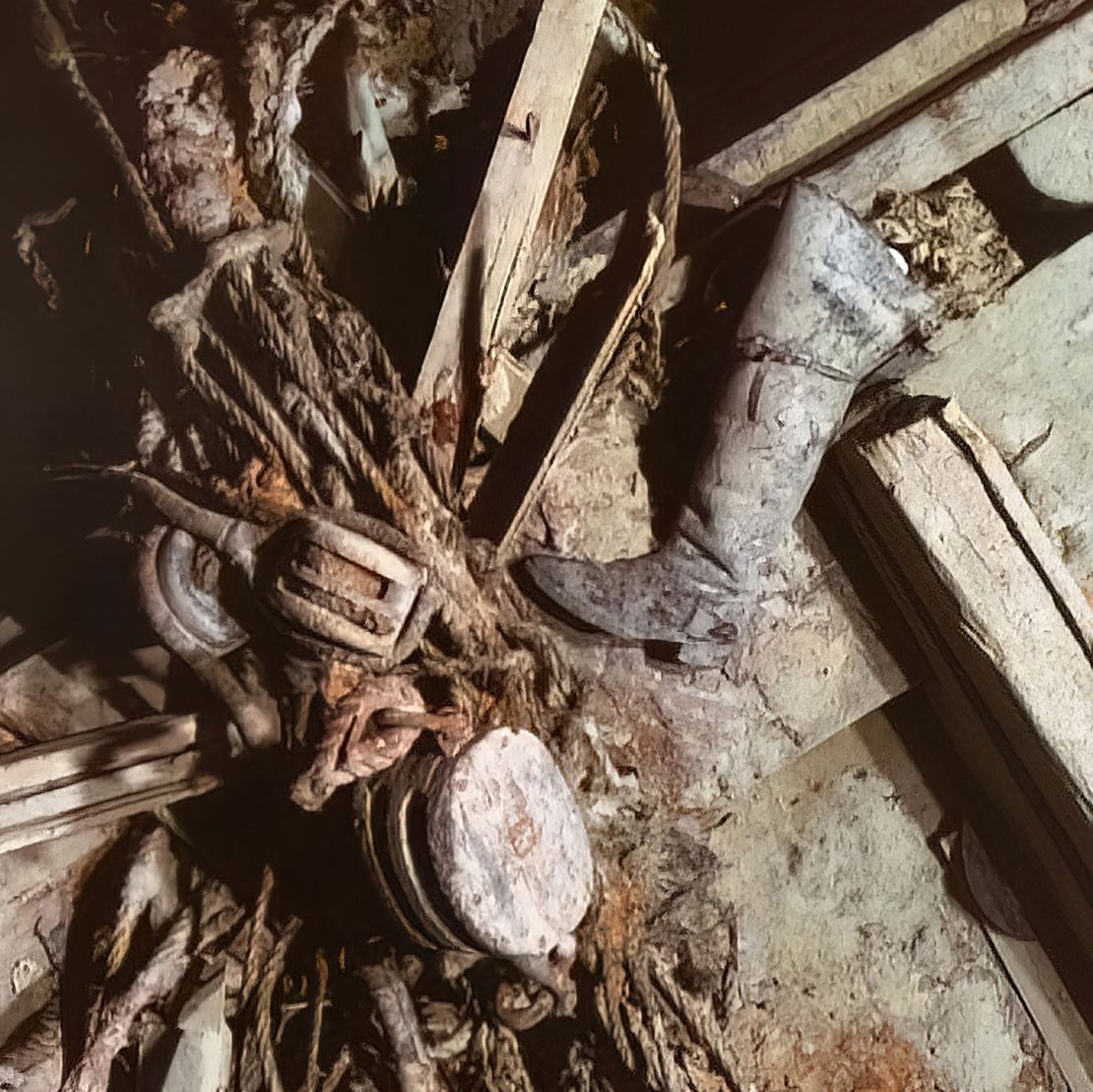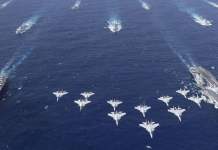A 3D scan has unveiled previously hidden details of the wreck of HMS Endurance, the famous vessel of Antarctic explorer Sir Ernest Shackleton. Discovered in 2022, a century after its sinking, this new scan offers a fresh and fascinating glimpse into one of the most iconic shipwrecks in history.
The HMS Endurance was lost in 1915 when it became trapped and eventually crushed by the unforgiving pack ice of the Weddell Sea. It now rests three kilometers below the surface of what Shackleton described as “the worst portion of the worst sea in the world.”
Despite the extreme conditions, the ship is remarkably well-preserved, and the new 3D images offer a vivid impression of how it has survived the passage of time.
The stunning images, compiled from thousands of digital scans, depict the Endurance as though it was miraculously lifted from the depths and placed intact onto dry land.
The level of preservation is astonishing: the rigging, helm, and intricate woodwork remain virtually untouched despite the century-long submersion in icy waters. These details offer a rare opportunity to see the ship in a condition far better than one might expect from such a historically significant wreck.
Among the many features highlighted in the scan are personal items left behind by Shackleton’s crew. Dining plates resting on the deck are a poignant reminder of the men who once sailed the Endurance.
Another artifact is a single knee-length boot, believed to have belonged to Frank Wild, Shackleton’s loyal second-in-command. Such relics provide a deeply personal connection to the crew’s harrowing experience.

One of the key discoveries from the wreckage is a flare gun, still visible among the debris. Expedition photographer Frank Hurley is believed to have used this gun when he fired it into the air as the Endurance sank.
Hurley’s diaries provide vivid accounts of this moment, transforming the discovery of the flare gun into an emotional connection to the ship’s final days.

The scans and images have been released as part of a new documentary film, Endurance, which will debut at the London Film Festival.
Directed by Chai Vasarhelyi, Jimmy Chin, and Natalie Hewit, the film is a joint effort from National Geographic Documentary Films. It chronicles Shackleton’s ill-fated voyage and the modern-day expedition that rediscovered the Endurance in 2022. The film is set to hit UK cinemas on October 14, with a later release planned on Disney+.
The Falklands Maritime Heritage Trust (FMHT) funded the discovery of the shipwreck and the creation of the documentary. Donald Lamont, the chairman of the FMHT, spoke about the project’s importance.
“As well as locating, surveying, and filming the wreck, our aim was to bring the stories of Shackleton and of his ship to new generations,” Lamont said in a statement. “These are stories of grit, determination, and leadership that can inspire people around the world to persevere in the face of adversity.”
The 3D scan was created using cutting-edge laser and photogrammetric technology, deployed at a depth never previously explored with such tools. The data gathered by underwater robots was used to compile over 25,000 scans, creating a detailed image of the wreck.
While the ship’s hull and masts show signs of damage from the crushing ice, the vessel remains surprisingly intact, proof enough of its robust construction and the freezing temperatures that have preserved it.
Endurance Trapped: Shackleton’s Crew Faces Icy Isolation
Before embarking on the Endurance voyage, Ernest Shackleton had already earned a solid reputation as a polar explorer, following a career in the merchant navy.
His initial foray into Antarctic exploration in 1906 was cut short due to health issues, but he returned in 1908 to lead a successful expedition further south. His achievements then were so significant that he was knighted, becoming Sir Ernest Shackleton in 1909.
Shackleton’s final mission to Antarctica began with high hopes and lofty goals. Assembling a crew of 27 men, his ambition was to be the first to lead an expedition across the entire Antarctic continent.
This dream followed closely after Norwegian explorer Roald Amundsen’s historic journey to the South Pole, making Shackleton eager to make his mark in polar history.
By December 1914, the crew had boarded the Endurance, a sturdy three-mast ship equipped with a reinforced wooden hull and a steam engine. Alongside the men were 69 dogs and a tomcat humorously named Mrs. Chippy.

Shackleton aimed to establish a base on the Weddell Sea coast of Antarctica. From there, he and a small team planned to embark on the first overland crossing of the continent, traveling towards the Ross Sea, where a second party would await them after setting up food and fuel depots along the route.
However, two days after leaving South Georgia, the ship entered the dense pack of ice that encircles the Antarctic. For weeks, the Endurance carefully navigated through the ice, inching its way south.
However, on January 18, 1915, a strong northern gale suddenly brought the ship’s journey to an unexpected standstill. The wind forced the ice together, trapping the ship. As crew member Thomas Orde-Lees described it, the Endurance was “frozen like an almond in a chocolate bar,” unable to move in any direction.
The crew found themselves tantalizingly close to their destination, only a day’s sail from land, but the shifting ice was now carrying them further from their goal each day. With no choice but to wait for the Antarctic winter to pass, Shackleton and his men settled into a routine, hoping the ice would eventually release the ship.
Despite several attempts to free the Endurance, whenever the ice appeared to loosen, the ship remained trapped.
On February 24, 1915, as winter deepened, the crew resigned themselves to staying put until the summer thaw, hoping the warmer months would provide an opportunity to escape the icy prison.
Struggling For Survival
After the crew of the Endurance was forced to abandon the ship, they salvaged as many supplies as possible before the ice finally engulfed it. Captain Frank Worsley meticulously charted the ship’s final position, using his navigational expertise to record its coordinates, which later proved crucial in the successful 2022 mission to locate the wreck.
In their bid for survival, the crew made painful sacrifices, discarding anything that would add unnecessary weight or consume precious resources. Items such as Bibles, clothing, tools, and sentimental keepsakes were left behind.
Tragically, some of the younger sled dogs, unable to pull their weight, were also put down, and much to the crew’s dismay, the ship’s tomcat, Mrs. Chippy, met the same fate.
Initially, Shackleton planned to lead his men across the ice toward land, but after a grueling seven days of marching and covering only seven and a half miles, it became clear that this approach was futile.
Shackleton later wrote that they had no choice but to set up camp again on the floe and wait as patiently as possible until conditions improved for another attempt to escape.

As the ice slowly drifted northward, hope began to grow. On April 7, 1916, the snow-capped peaks of Clarence and Elephant Islands came into sight, lifting the men’s spirits.
In his diary, Shackleton mentioned that the floe had been a reliable companion, but it was nearing the end of its journey and could break apart at any moment.
Two days later, on April 9, the ice beneath them cracked open with a thunderous sound. Shackleton immediately ordered them to break camp and launch the boats, finally freeing them from the ice that had trapped and sheltered them for months.
However, the open ocean brought new challenges. Freezing water splashed on their faces as the boats were tossed by turbulent waves, causing some men to surrender to seasickness and exhaustion. Captain Worsley continued to navigate through the harsh conditions, steering through squalls and icy winds.
After six exhausting days at sea, the sight of Clarence and Elephant Islands, 30 miles ahead, brought renewed determination. Though some were debilitated by seasickness and dysentery, the crew rowed on, and on April 15, 1916, they finally reached the shore of Elephant Island, safe at last.
Shackleton’s Spirit & Rescue Of His Crew
Days later, with his crew’s physical and mental health deteriorating, Shackleton, along with Endurance captain Worsley, carpenter Harry McNish, and two others, set out on the most dangerous leg of their journey: an 800-mile trek across treacherous seas toward South Georgia Island, where a whaling station held the promise of rescue.
After 16 days of battling huge waves in a 22-foot lifeboat, they reached land but found themselves on the wrong side of the island, with a daunting mountain range between them and the whaling station.
Undeterred, Shackleton left two men behind and, with Worsley and Irish sailor Tom Crean, began the arduous trek across the uncharted mountains in search of help.
They ascended ridges reaching 3,000 feet, navigating glaciers, skirting around sheer cliffs, and descending through a freezing waterfall before finally arriving at the whaling station in Stromness Bay. To their immense relief, station manager Thorlaf Sørlle immediately welcomed them with food, shelter, and aid.
The manager offered them coffee and cakes in traditional Norwegian style, then guided them upstairs to a bathroom where they could strip off their rags and indulge in a much-needed wash.
Meanwhile, Shackleton’s crew members across South Georgia were quickly rescued. However, rough seas and ice around Elephant Island thwarted attempts to reach the other 22 men, including Frank Wild, who remained camped there.
Finally, on August 30, Shackleton reached them as they were depleting their final food rations. Remarkably, no lives had been lost. They then set sail for Chile, arriving in Punta Arenas on September 3, 1916, to congratulations and support from around the globe.
Although Shackleton’s expedition was a profound failure, his achievement in keeping his crew alive and ensuring their safe rescue far surpassed any glory associated with exploration.
- Contact the author at ashishmichel(at)gmail.com
- Follow EurAsian Times on Google News




